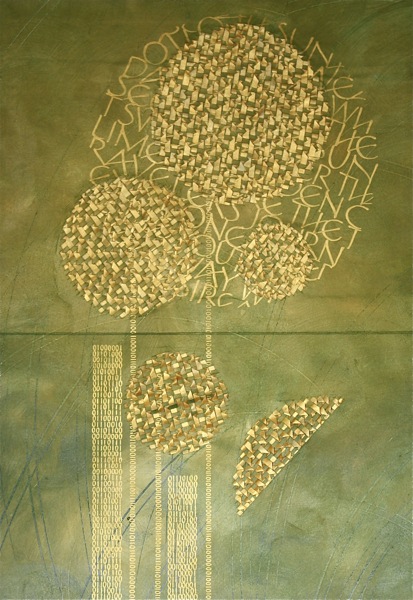In this final show of the year, Abecedarian Gallery presents Hand Lettered, a group exhibition featuring artists whose works include hand lettered elements as either primary content or concept.
The book arts umbrella under which Abecedarian happily lives, includes a variety of mark making techniques. The use of letterpress is ongoing, ever more sophisticated and widely available digital processes have introduced production means to a broader range of artists than ever before. These days more writing is done digitally than with pen or pencil in hand.
A side effect of this that I consider unfortunate is that hand-lettered work is losing ground as a viable form of generating text. Hand calligraphy has given way to digital typesetting and thus seems quaint and archaic.
For Hand Lettered, I sought artists whose work makes use of the hand-drawn letter without calling too much attention to that fact. The artists in this exhibition have created works that transcend the tactic.
The exhibition features work by Heidi Zednik, Jan Owen, Justin Quinn and Mamiko Ikeda alongside books and sculptures by seventeen other artists from throughout the United States, Germany and Argentina.
Heidi Zednik is represented by Abecedarian Gallery and has been included in several previous exhibits. Here exhibited are several works created particularly for this exhibition. A dual citizen Austrian/American Zednik uses both painting and original texts in her works on paper, her studio work a recognition that art can be a catalyst for beauty, for peace and for being still.

Maine artist Jan Owen has also been included in previous exhibitions at Abecedarian. Captivated by the gestures found in handwritten letters, she often works with texts written by others. More than marks made on specific surfaces, Owen’s work integrates surface with mark, which she does by working on translucent materials that are layered, or by weaving materials back into the original surface.

New to Abecedarian is Justin Quinn, a printmaker currently living in St. Cloud, MN, displaying both books and prints from his Moby Dick series. Quinn has altered Melville’s epic novel by changing all letters to the letter E, thus abstracting the text away from something that is read into something that is seen. Both a bound copy of the original graphite drawings, and a photocopy version installed on the wall will be on view, alongside an intaglio print.
Also new to the gallery is Mamiko Ikeda. Born in Tokyo, Mamiko has lived in Colorado since 1995. She learned Japanese calligraphy from her mother, master calligrapher Shotei Miura. Here are exhibited several monotypes with calligraphy, works created as a form of meditation, the brush movements reflecting her moods, feelings and thoughts and hand painted boxes, each containing hand-lettered and printed manga scrolls.

Hand Lettered also includes artists’ books by the following artist:
Carol Erickson (Albuquerque, New Mexico)
Carol Es – (Los Angeles, Califronia)
Cheryl Bailey/Deborah Henson (Denver/Longmont, Colorado)
Danielle Feliciano (St Louis Park, Minnesota)
Elizabeth McKee (Pasadena, Maryland)
Ellen Wiener (Southold, New York)
Friedrich Kerksieck (Memphis, Tennessee)
Jennifer Hines (Chicago, Illinois)
Kristen Catlett – (Booneville, Arkansas)
Marí Emily Bohley (Dresden, Germany)
Marina Soria (Buenos Aires, Argentina)
Stephen Sidelinger – (Venice, Florida)
Sun Young Kang – (Bryn Mawr, Pennsylvania)
Susan Kapuscinski Gaylord (Newburyport, Massachusetts)
Turner Hilliker (Philadelphia, Pennsylvania)
As well as works by
E. Brooke Lanier (Philadelphia, Pennsylvania)
Connie Norman (Cheyenne, Wyoming)
Alicia Bailey, Gallery Director & Curator


































 As an artist Susan understands the myriad stances a viewer might take when approaching a work whether for the first time or on a return visit. An intelligent selection of forms and objects that are the result of much thinking before hand separates these works from what is so often found in contemporary assemblage/collage works.
As an artist Susan understands the myriad stances a viewer might take when approaching a work whether for the first time or on a return visit. An intelligent selection of forms and objects that are the result of much thinking before hand separates these works from what is so often found in contemporary assemblage/collage works. 


 A variation from this method is apparent in You Won’t See Me At the Anchor Inn. Although made from more conventional materials it, too, is a structural experiment, which turns a flat 9×12 collage into a small pop-up book which, fully unfolded in a meander format, betrays its single-sheet origins.
A variation from this method is apparent in You Won’t See Me At the Anchor Inn. Although made from more conventional materials it, too, is a structural experiment, which turns a flat 9×12 collage into a small pop-up book which, fully unfolded in a meander format, betrays its single-sheet origins.
